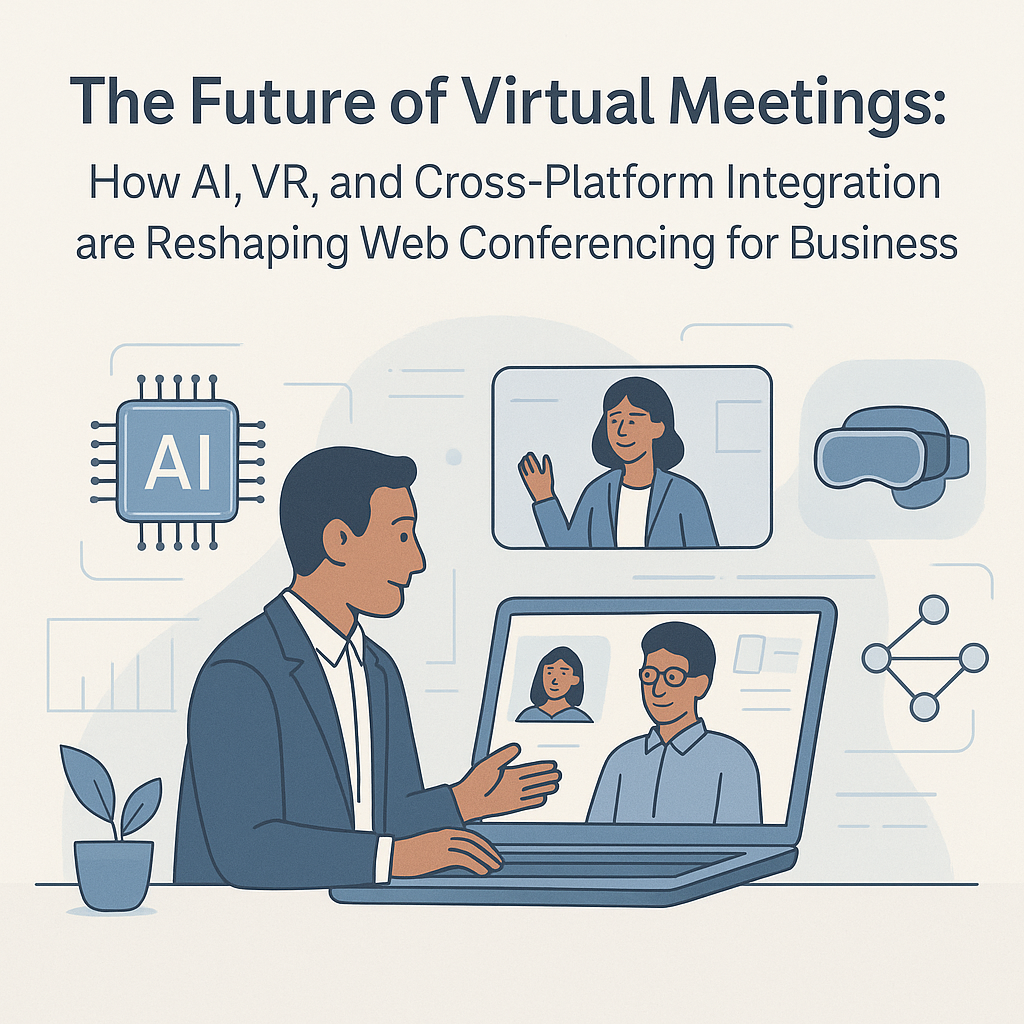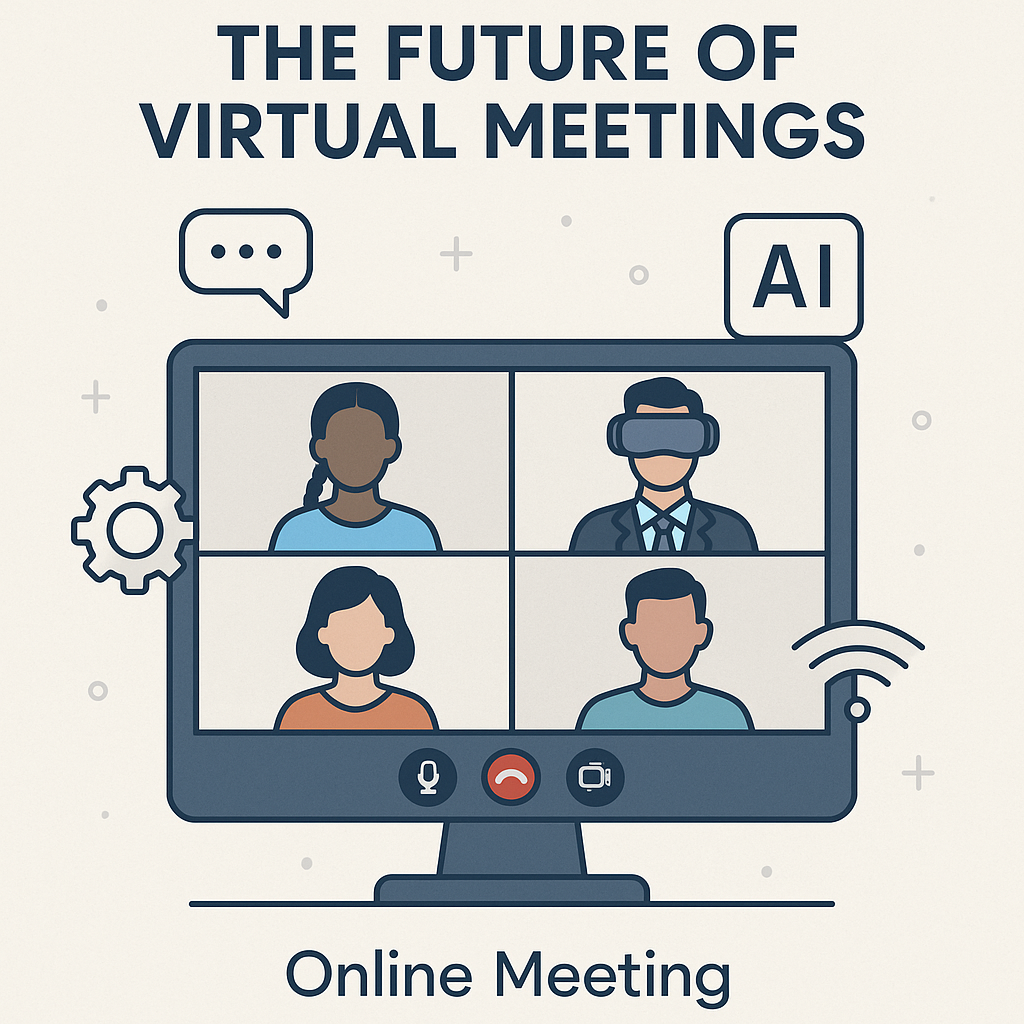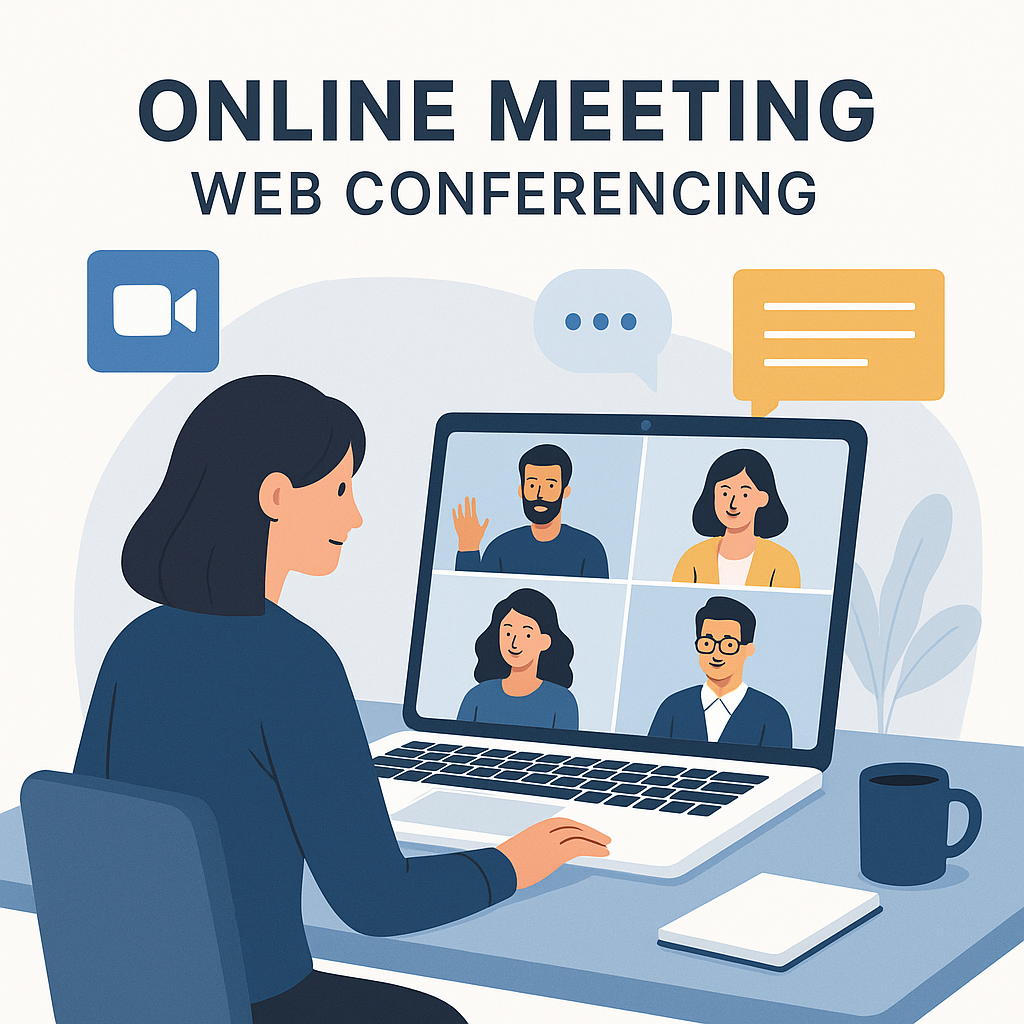The Future of Virtual Meetings: How AI, VR, and Cross-Platform Integration are Reshaping Web Conferencing for Business

The way we connect, collaborate, and conduct business has undergone a seismic shift, especially in the last few years. What was once considered a niche or supplementary tool, the virtual meeting, has now become the backbone of global operations. From quick daily stand-ups to intricate client presentations, web conferencing platforms have evolved from simple video calls into sophisticated collaboration hubs. But this evolution is far from over. We're on the cusp of an even more radical transformation, driven by the rapid advancements in Artificial Intelligence (AI), Virtual Reality (VR), and the pressing need for seamless cross-platform integration.
The future of online meeting web conferencing isn't just about seeing and hearing one another; it's about creating intelligent, immersive, and effortlessly integrated experiences that transcend geographical boundaries and enhance productivity. This article delves into how these groundbreaking technologies are reshaping the landscape of virtual meetings for businesses, offering a glimpse into a future where collaboration is more intuitive, impactful, and efficient than ever before.
The Rise of AI in Web Conferencing: Smart Assistants, Real-time Transcription, and Analytics for Enhanced Engagement
Artificial Intelligence is no longer a futuristic concept; it's actively revolutionizing nearly every sector, and AI in virtual meetings is leading the charge in transforming how we interact in the digital space. Beyond basic noise cancellation, AI is making web conferencing smarter, more accessible, and significantly more productive. Imagine a meeting where every word is captured, every action item identified, and every participant's engagement understood – that's the power AI brings to the table.
Smart Meeting Assistants and Automated Processes
- Automated Scheduling and Reminders: AI-powered assistants can analyze calendars, suggest optimal meeting times, and send out reminders, drastically reducing the administrative burden.
- Intelligent Note-Taking and Summarization: Forget furiously typing during a call. AI can transcribe conversations in real-time, identify key discussion points, summarize decisions, and even highlight action items with assigned owners. This ensures no crucial detail is missed and follow-ups are streamlined.
- Real-time Translation: For global teams, language barriers can be a significant hurdle. AI offers real-time translation capabilities, allowing participants to communicate seamlessly regardless of their native tongue, fostering truly international collaboration.
Enhanced Engagement and Analytics
- Sentiment Analysis: Advanced AI algorithms can analyze vocal tone, facial expressions (with consent), and speech patterns to gauge participant sentiment and engagement levels. This provides valuable insights to presenters, helping them adapt their delivery to keep the audience captivated.
- Automated Feedback and Performance Metrics: AI can track metrics like speaking time, interruptions, and participation rates, offering data-driven insights into meeting dynamics. This allows organizations to optimize meeting structures and identify areas for improvement in communication.
- Personalized Content Delivery: AI can learn user preferences and suggest relevant documents, data points, or even follow-up materials during or after a meeting, ensuring participants have all the necessary information at their fingertips.
Microsoft Teams, for instance, leverages AI and machine learning to improve call quality, background blur, and live captions. These capabilities not only enhance the user experience but also contribute significantly to the overall efficiency and inclusivity of virtual meetings. The future of online collaboration is undeniably intelligent, driven by these powerful AI integrations.
Immersive Experiences: Exploring Virtual and Augmented Reality Applications in Business Meetings
While AI makes virtual meetings smarter, Virtual Reality (VR) and Augmented Reality (AR) are poised to make them profoundly more immersive. Moving beyond the flat, 2D grid of faces, VR web conferencing promises to transport participants into shared digital spaces, fostering a sense of presence and connection that traditional video calls simply cannot replicate.
Virtual Reality (VR) for Collaborative Spaces
Imagine donning a VR headset and stepping into a virtual boardroom, a collaborative design studio, or even a sprawling conference hall, all from the comfort of your home office. This is the promise of VR in business meetings:
- Enhanced Presence: VR creates a strong sense of "being there" with colleagues, which can significantly improve non-verbal communication and team cohesion. Avatars can convey body language, spatial awareness, and even eye contact.
- Collaborative Workspaces: Teams can interact with 3D models, annotate shared documents on virtual whiteboards, or walk through product prototypes together. This is particularly transformative for fields like architecture, engineering, product design, and manufacturing.
- Reduced Distractions: VR environments can be designed to minimize external distractions, allowing participants to fully immerse themselves in the meeting.
- Training and Simulations: Beyond meetings, VR offers unparalleled opportunities for immersive training scenarios, onboarding, and complex simulations that would be impossible or too costly in the physical world.
Augmented Reality (AR) for Interactive Overlays
AR, unlike VR, overlays digital information onto the real world. While less about full immersion, AR offers practical applications for enhancing virtual meetings:
- Interactive Presentations: Presenters can project 3D models, data visualizations, or interactive diagrams directly into their physical space, allowing for more dynamic and engaging presentations.
- Remote Assistance and Support: Technicians can guide remote colleagues through complex repairs or installations by superimposing instructions, diagrams, or arrows onto their real-world view.
- Product Demonstrations: Sales teams can showcase products in a client's environment, allowing them to visualize how an item might look or function in their specific context.
While the widespread adoption of VR and AR for everyday business meetings is still nascent due to hardware costs and accessibility, these technologies represent the cutting edge of the future of online collaboration. As headsets become more affordable and ergonomic, and platforms become more robust, immersive experiences will increasingly become a standard feature of advanced web conferencing.
Seamless Integration: Achieving Cross-Platform Compatibility and Streamlined Workflows
One of the biggest frustrations in the current landscape of online collaboration is the fragmented ecosystem of tools. Businesses often juggle multiple platforms for communication, project management, CRM, and email management. This leads to "tool fatigue," data silos, and inefficient workflows. The future of online meeting web conferencing hinges on seamless cross-platform meeting tools that unify these disparate systems.
The Need for Interoperability
True cross-platform compatibility means that a meeting initiated on one service can be easily joined by participants using another, or that features and data can flow effortlessly between different applications. This is achieved through:
- Open APIs and Standards: Industry-wide adoption of open Application Programming Interfaces (APIs) and communication standards allows different platforms to "talk" to each other.
- Universal Connectors: Tools that act as bridges between various conferencing, chat, and project management applications.
- WebRTC Advancements: Web Real-Time Communication (WebRTC) is a technology that enables real-time voice, video, and data communication directly within web browsers, reducing the need for proprietary plugins and enhancing universal access.
Benefits of Streamlined Workflows
When cross-platform meeting tools become the norm, businesses experience significant advantages:
- Reduced Friction: No more scrambling to download specific software or struggling with compatibility issues. Joining a meeting becomes as simple as clicking a link.
- Improved Productivity: Teams spend less time switching between applications and more time focusing on productive work. Information is centralized, making it easier to find and act upon.
- Enhanced Data Flow: Meeting notes, action items, and shared files can automatically sync with project management tools, CRM systems, or internal knowledge bases. For instance, a decision made in a meeting could instantly update a task in Asana or a lead status in Salesforce.
- Better Collaboration: When all tools are integrated, teams can collaborate more fluidly, sharing ideas and making decisions without interruption.
- Simplified IT Management: A unified ecosystem reduces the complexity for IT departments, making it easier to manage software, security, and user access.
Major players like Microsoft Teams and Google Workspace are already moving towards this unified communication platform model, integrating video conferencing with chat, document sharing, and other business applications. The goal is to create a seamless digital workspace where all aspects of collaboration coexist harmoniously, making the online meeting web conferencing experience truly integrated.
Quantifying the Impact: ROI of Advanced Web Conferencing for Cost Savings and Productivity Gains
While the technological advancements are exciting, businesses ultimately need to see a tangible return on investment. The virtual meeting ROI, particularly with advanced web conferencing solutions, extends far beyond simply connecting people remotely. It translates into significant cost savings, enhanced productivity, and a stronger competitive edge.
Tangible Cost Savings
- Reduced Travel Expenses: This is perhaps the most obvious benefit. Eliminating or significantly reducing business travel for meetings, conferences, and training sessions can save companies millions annually. For example, a global corporation with thousands of employees might save tens of thousands of dollars per employee per year in flights, accommodation, and per diems by opting for virtual engagements.
- Lower Real Estate Costs: The ability to support a remote or hybrid workforce reduces the need for extensive physical office space. Companies can downsize their real estate footprint, leading to substantial savings on rent, utilities, and maintenance.
- Operational Efficiency: Automated features like AI note-takers and summarizers reduce the need for manual administrative work, freeing up employee time for more strategic tasks.
Significant Productivity Gains
- Faster Decision-Making: With instant access to colleagues and shared information through integrated platforms, decisions can be made more quickly, accelerating project timelines.
- Increased Meeting Efficiency: AI-powered features ensure meetings are more focused, productive, and actionable. Less time is wasted on logistics or recapping, and more time is spent on core discussions. A study by the National Bureau of Economic Research found that remote work can increase productivity by 5%, partly due to reduced commute times and greater autonomy over work schedules.
- Improved Collaboration: Immersive VR environments and seamless cross-platform tools foster deeper, more engaging collaboration, leading to better outcomes for projects and initiatives.
- Enhanced Employee Engagement and Retention: Offering flexibility through advanced remote work tools can boost employee satisfaction and morale, reducing turnover rates and attracting top talent. A highly engaged workforce is often a more productive one.
Real-World Examples of ROI
Consider a hypothetical multinational consulting firm, "GlobalConnect Solutions." Before adopting advanced online meeting web conferencing, they spent an average of $5,000 per month per consultant on travel for client meetings. By implementing a robust AI-driven platform with VR capabilities for client presentations, they:
- Reduced travel expenses by 70% within the first year, saving over $400,000 annually across their consultant base.
- Increased client engagement by 20% in virtual pitches, leading to a 15% higher close rate due to the immersive and interactive VR presentations.
- Cut down meeting preparation time by 30% thanks to AI-powered summary generation and automated action item tracking, allowing consultants to focus more on strategic client work.
These gains are not just theoretical; they represent a tangible competitive advantage. Companies that invest in the future of online collaboration are positioning themselves for greater efficiency, lower costs, and superior business outcomes.
Future Outlook: Anticipating the Next Wave of Innovations in Online Collaboration
The journey of online meeting web conferencing is far from over. As technology continues its relentless march forward, we can anticipate even more groundbreaking innovations that will further blur the lines between physical and virtual collaboration, pushing the boundaries of the future of online collaboration.
Holographic Meetings and Beyond
Imagine truly lifelike holographic projections of participants appearing in your physical meeting room, or you appearing as a hologram in theirs. While still largely in the realm of science fiction, advancements in light field display technology and high-bandwidth networking could make this a reality within the next decade, offering an unparalleled sense of presence.
Neuro-Adaptive Interfaces and Emotion AI
Future systems might go beyond basic sentiment analysis. Neuro-adaptive interfaces could potentially read subtle cues (with explicit user consent) and adjust meeting parameters – such as pacing, visual complexity, or even who speaks next – to optimize for cognitive load and engagement. Emotion AI will become more sophisticated, offering nuanced insights into participant reactions, allowing presenters to dynamically tailor their content and delivery for maximum impact.
Deeper Metaverse Integration
The concept of the metaverse – a persistent, interconnected set of virtual worlds – will likely play a significant role. Future virtual meetings might not be isolated sessions but rather take place within persistent digital twin environments of offices, factories, or even entire cities, where teams can collaborate on projects that exist both virtually and physically.
Hyper-Personalization and Predictive Collaboration
AI will become even more adept at understanding individual work styles and preferences. Meeting platforms could proactively suggest relevant content, identify potential roadblocks before they arise, or even recommend optimal team configurations for specific tasks, moving towards a truly predictive collaboration environment.
Ethical Considerations and Data Privacy
As these technologies become more sophisticated, ethical considerations surrounding data privacy, AI bias, and the psychological impact of immersive environments will become paramount. Future developments will need to prioritize robust security measures, transparent data handling, and user well-being to ensure responsible innovation in AI in virtual meetings.
The trajectory points towards a future where online meeting web conferencing is not just a tool, but an intelligent, intuitive, and deeply integrated part of our daily work lives, making remote and hybrid work more effective and engaging than ever before.
Conclusion: Embracing the Future of Collaboration for Competitive Advantage
The landscape of business communication is undergoing a profound transformation, moving rapidly from basic video calls to a sophisticated ecosystem powered by Artificial Intelligence, Virtual Reality, and seamless cross-platform integration. The era of static, two-dimensional online meetings is rapidly giving way to dynamic, intelligent, and immersive collaborative experiences.
For businesses, this evolution isn't merely a technological upgrade; it's a strategic imperative. Embracing advanced online meeting web conferencing solutions offers a compelling return on investment, delivering significant cost savings through reduced travel and real estate, while simultaneously boosting productivity and employee engagement. AI-driven insights ensure meetings are more efficient, VR and AR foster deeper connection and innovative problem-solving, and cross-platform tools streamline workflows, eliminating friction and enhancing overall operational fluidity.
The future of online collaboration is here, and it promises a competitive advantage to those who are willing to adapt and innovate. By strategically integrating these cutting-edge technologies, businesses can not only weather the challenges of a distributed workforce but thrive in a globalized, digitally-driven economy. The time to invest in the future of your virtual meetings is now, positioning your organization at the forefront of productivity, innovation, and sustainable growth.



